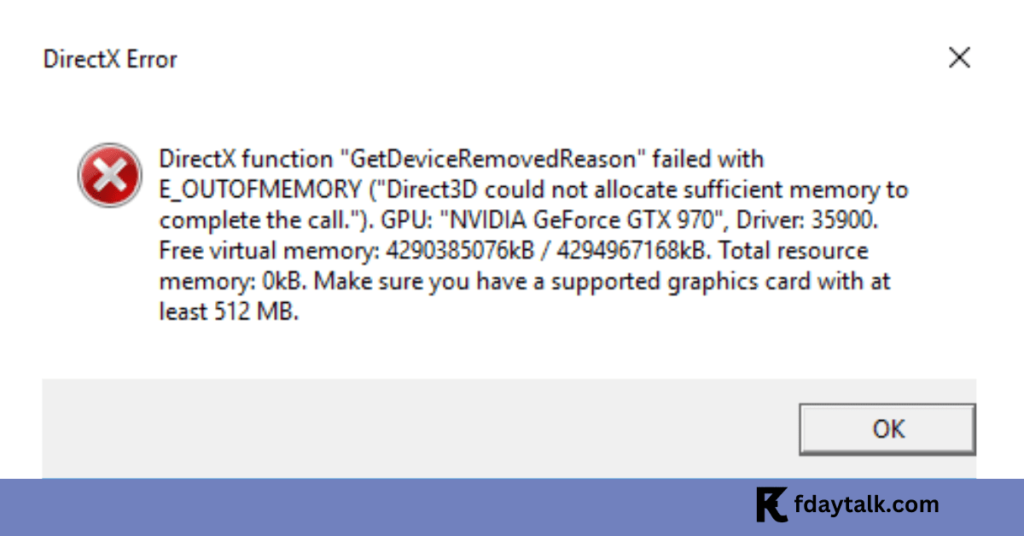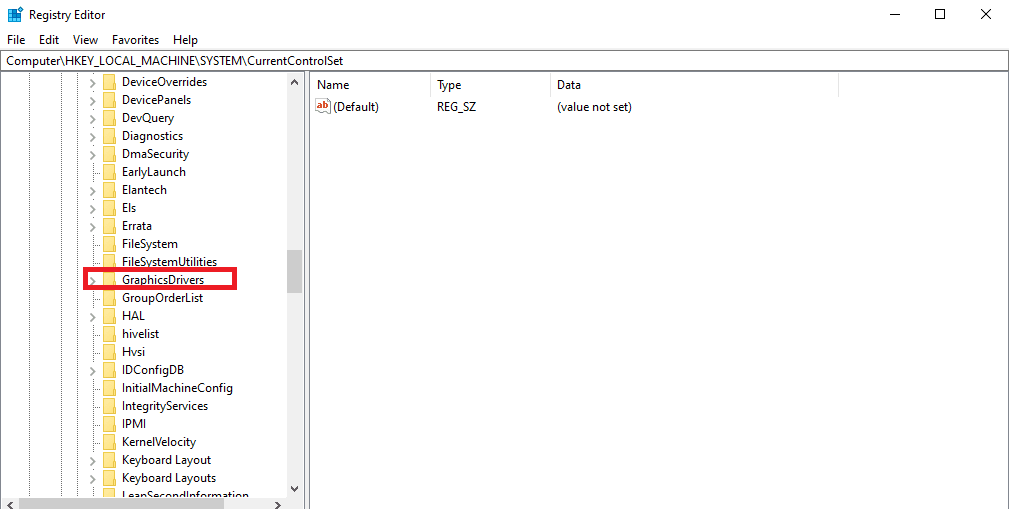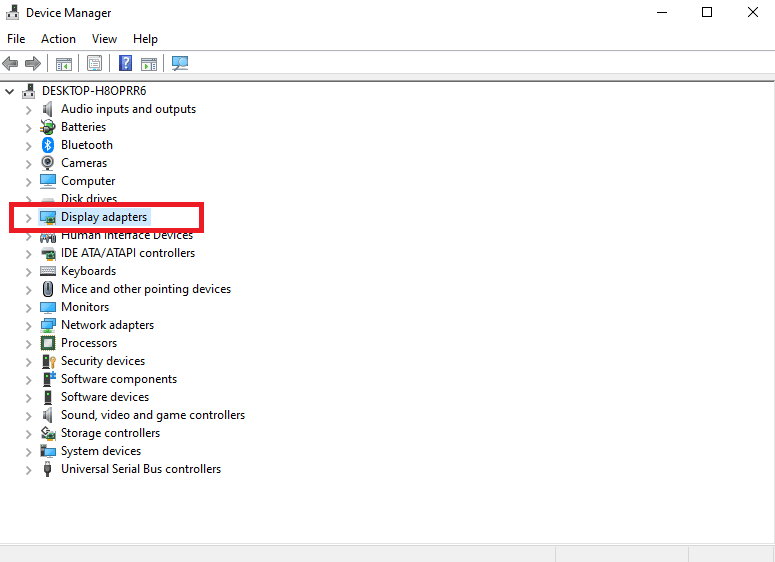The “GetDeviceRemovedReason” error can be incredibly frustrating, especially when it interrupts your gaming experience. This error is typically caused by issues with your GPU (graphics processing unit) losing connection with your system. Whether you’re playing graphics-intensive games like Baldur’s Gate 3 or running demanding applications, this error can strike unexpectedly.
DirectX Error:
DirectX function “GetDeviceRemovedReason” failed with E_OUTOFMEMORY (“Direct3D could not allocate sufficient memory to complete the call.”).
GPU: “NVIDIA GeForce GTX 970”, Driver: 35900.
Free virtual memory: 4290385076kB / 4294967168kB. Total resource memory: 0kB. Make sure you have a supported graphics card with at least 512 MB.
But don’t worry! Here, we’ll walk you through the top solutions to fix this issue and enjoy a seamless gaming experience.
What is GetDeviceRemovedReason?
The “GetDeviceRemovedReason” error is a function within DirectX that indicates why the GPU stops communicating with the system. This error is often related to:

- GPU Overheating or Overclocking: Overclocking increases the GPU’s workload and can lead to overheating, causing the error.
- Outdated or Incompatible Graphics Drivers: Older or buggy drivers may fail to maintain stable GPU communication.
- Registry Misconfigurations: Certain Windows registry settings related to GPU response times can trigger the error.
- Hardware Acceleration Conflicts: Features like Shadow Play or Anti-Aliasing can clash with the GPU.
- Power Management Settings: Improper GPU power settings can force the GPU to disconnect.
Top Fixes for GetDeviceRemovedReason
Below are tried-and-tested solutions to resolve the “GetDeviceRemovedReason” error:
1. Turn Off Shadow Play or In-Game Overlay (GeForce Experience)
The Shadow Play feature in GeForce Experience can sometimes conflict with GPU stability. Disabling it often resolves the issue:
- Open GeForce Experience and run it as an administrator.
- Go to the General tab on the left panel.
- Turn off the In-Game Overlay or Share feature.
- Save your settings and reboot your PC.
2. Modify Registry Settings
Adjusting the TDR (Timeout Detection and Recovery) settings in the Windows registry can prevent the GPU from being disabled when it’s unresponsive for short periods.
- Press
Win + Rto open the Run dialog box. - Type
regeditand press Enter. - Navigate to:
Computer\HKEY_LOCAL_MACHINE\SYSTEM\CurrentControlSet\Control\GraphicsDrivers

- Right-click on the blank space and select New > DWORD (32-bit) Value.
- Name it TDRLevel and set its value to
0. - Save the changes and restart your computer.
Note: Setting TDRLevel to
0disables GPU timeout detection, which can help prevent the error, including “GetDeviceRemovedReason.”
3. Disable Anti-Aliasing in Nvidia Control Panel
Anti-Aliasing, while improving visual quality, can sometimes cause GPU instability. Disabling it may help:
- Right-click on your desktop and select Nvidia Control Panel.
- Navigate to Manage 3D Settings > Global Settings.
- Turn off all Anti-Aliasing options.
- Click Apply to save the changes.
4. Update or Roll Back Graphics Drivers
Outdated or buggy graphics drivers are a common culprit for this error. Follow these steps:
To Update Drivers:
- Open Device Manager by searching for it in the Start menu.
- Expand Display Adapters and right-click on your GPU.

- Select Update Driver and choose Search Automatically for Updated Driver Software.
To Roll Back Drivers:
- Open Device Manager and right-click on your GPU.
- Select Properties and go to the Driver tab.
- Click Roll Back Driver to revert to a previous version.
5. Underclock the GPU
If your GPU is overclocked, reducing its clock speed can stabilize its performance:
- Download and install MSI Afterburner.
- Lower the GPU clock speed by 50 MHz or more.
- Save the settings and test your game.
6. Disable XMP in BIOS
XMP (Extreme Memory Profile) can cause instability, especially if your RAM is overclocked. To disable it:
- Restart your PC and enter BIOS (usually by pressing
F2,F10, orDelduring boot). - Locate the XMP settings under the Memory or Overclocking section.
- Disable XMP and save the changes.
- Reboot your system.
7. Adjust Power Management Settings
Improper power settings can cause the GPU to overwork and disconnect. Fix it by:
- Open Nvidia Control Panel.
- Navigate to Manage 3D Settings > Global Settings.
- Change Power Management Mode to Normal or Adaptive.
- Save and exit.
8. Limit In-Game Frame Rates
High FPS can overburden the GPU and trigger the error. Limiting your frame rate may help:
- Open your game’s settings menu.
- Set a frame rate cap to 60 FPS or lower.
- Save the changes and restart the game.
Additional Tips
- Keep BIOS Updated: Ensure your motherboard’s BIOS is up to date.
- Monitor System Temperatures: Use tools like HWMonitor to check GPU and CPU temperatures.
- Disable Overlays: Turn off overlays for apps like Steam, Discord, or Nvidia Experience.
- Switch Display Ports: Try using HDMI instead of DisplayPort (or vice versa) to rule out port issues.
Conclusion
The “GetDeviceRemovedReason” error can disrupt your gaming experience, but it is fixable with the solutions provided above. Whether it’s adjusting registry settings, disabling overlays, underclocking your GPU, or updating drivers, there’s a fix that’ll work for your setup. Consistency and careful monitoring of your system’s performance are key to avoiding these issues in the future.
If you’ve resolved this error using any of these methods, share your experience in the comments below. Happy gaming!
More Tech Guides
- 01How to Install Sysinternals Suite on Windows 10/11
- 02How to Fix Windows Blue Screen Error 0x000000000000010E After Hibernation
- 03Windows 11 Firewall Best Practices: 8 Ways to Secure Your PC
- 04Windows 11 Installation Has Failed Error: How to Fix Upgrade Problems
- 05How to Fix Windows 11 HYPERVISOR ERROR BSOD on Boot or Resume From Sleep
- 06Windows 11 Installation Stuck or Fails During Upgrade Process (How to Fix)
- 07Windows Upgrade Error 0x8007042B-0x2000D When Updating From 23H2 to 25H2 (How to Fix)
- 08How to Fix Windows 11 Version 25H2 Update Error 0x8007001F